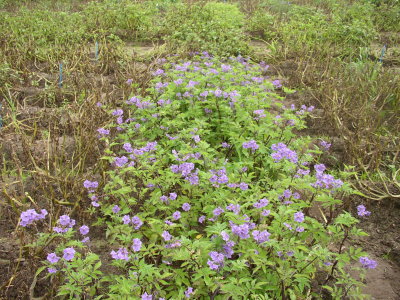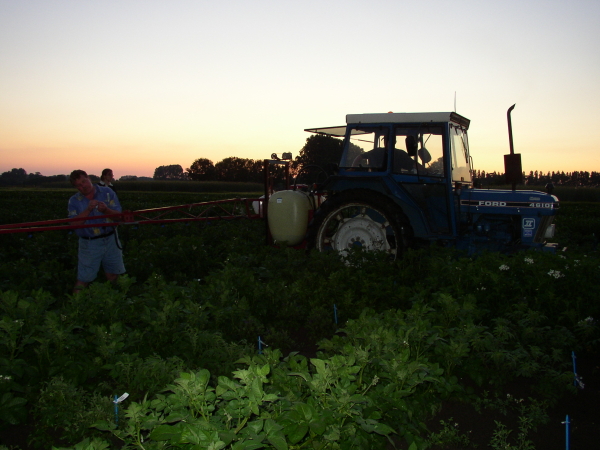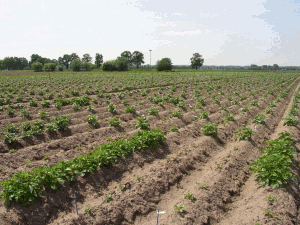SolRgene
In vitro inoculation assay
Field trial
Experimental set up
Field trials were performed in the summer of 2005 and 2007, in Wageningen, the Netherlands. Each field trial consisted of two randomized blocks, and within the blocks, genotypes were represented as four-plant subplots which were treated as a single experimental units as described by Colon and Budding (1988). For comparisons between years, standard cultivars Ostara, Bildtstar, Eersteling, Pimpernel, Robijn and Biogold were included. Spreader rows consisted of potato cultivar Bintje, the border rows of potato cultivar Nicola.
Plant material
All plant genotypes were propagated in vitro in sterile jars containing MS medium (Murashige and Skoog 1962) supplemented with 3% (w/v) sucrose at 20 °C. After 1-2 weeks of rooting, the in vitro plantlets were transferred to pots with sterilized soil in the greenhouse. After a few weeks of growing, little plants were gradually adapted to outside weather conditions, and then planted in the field to develop further into mature plants.

Resistance of S. papita (370) while the surrounding plants are suffering from the P. infestanse infection (field trial 2007)
Inoculation
Phytophthora infestans isolate IPO-C was grown on rye agar medium supplemented with 2% (w/v) sucrose (Caten and Jinks 1968) and incubated at 15°C in the dark for 1-2 weeks. For inoculation, a plate covered with mycelium was flooded with water and the sporangiospore suspension was pipetted into a test tube and incubated at 4°C. After zoospore release, the suspension was inoculated on a large number of potato cultivar Bintje leaves, and incubated in humid trays at 15°C. After 6 days, the spore suspension was collected in large containers and zoospore release was induced by incubating the containers at 10°C. At nightfall, the zoospore suspension was spayed on the potato field using a tractor with two spraying arms.

Figure 1: Inoculation of the field with P. infestans isolate IPO-C
Disease assessment
Disease assessments were made at weekly intervals. The percentage of leaf area covered with late blight lesions was estimated for each plot (Colon and Budding 1988). From these readings the area under the disease progress curve (ADPC) was calculated (Fry 1978), and subsequently, the ADPC values were transformed to a 1 (susceptible) -9 (resistant) scale.

Video of the 2005 field trial
References
- Caten, C. E., and Jinks, J. L. 1968. Spontaneous variability of single isolates of Phytophthora infestans I. Cultural variation. Canadian Journal of Botany 46:329-347.
- Colon, L. T., and Budding, D. J. 1988. Resistance to late blight (Phytophthora infestans) in ten wild Solanum species. Euphytica Supplement:77-86.
- Fry, W. E. 1978. Quantification of general resistance of potato cultivars and fungicide effects for integrated control of potato late blight. Phytopathology 68:1650-1655.
- Murashige, T., and Skoog, F. 1962. A revised medium for rapid growth and bioassays with tobacco tissue cultures. Physiologia Plantarum 15:473-497.